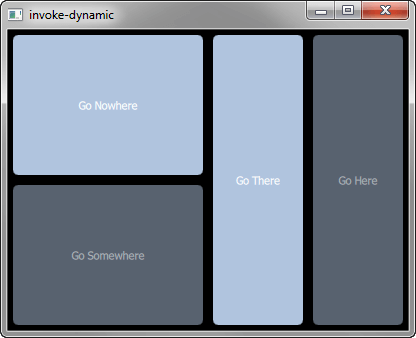
Invokes a dynamically loaded nested state machine.

Invoke Example (Dynamic) demonstrates how to use the <invoke> element with generated nested state-machines, where the SCXML file is dynamically loaded. The <invoke> element is
used to create an instance of an external service.
To run the example from Qt Creator, open the Welcome mode and select the example from Examples. For more information, visit Building and Running an Example.
In statemachine.scxml, we specify a state machine with the name Directions of type http://www.w3.org/TR/scxml/ to invoke:
<scxml
xmlns="http://www.w3.org/2005/07/scxml"
version="1.0"
name="Directions"
initial="anyplace"
>
<state id="anyplace">
<transition event="goNowhere" target="nowhere"/>
<transition event="goSomewhere" target="somewhere"/>
<state id="nowhere"/>
<state id="somewhere">
<invoke type="http://www.w3.org/TR/scxml/">
<content>
<scxml name="anywhere" version="1.0">
<state id="here">
<transition event="goThere" target="there"/>
</state>
<state id="there">
<transition event="goHere" target="here"/>
</state>
</scxml>
</content>
</invoke>
</state>
</state>
</scxml>
We link against the Qt SCXML module by adding the following line to the project build files.
With qmake to the invoke-dynamic.pro
QT += qml scxml
With cmake to the CMakeLists.txt
find_package(Qt6 REQUIRED COMPONENTS Core Gui Qml Scxml)
target_link_libraries(invoke-dynamic PUBLIC
Qt6::Core
Qt6::Gui
Qt6::Qml
Qt6::Scxml
)
We dynamically create the state machine, as follows:
import QtScxml MainView { stateMachine: directions.stateMachine StateMachineLoader { id: directions source: "qrc:///statemachine.scxml" }

As part of the free Business evaluation, we offer a free welcome call for companies, to talk about your requirements, and how the Felgo SDK & Services can help you. Just sign up and schedule your call.
Sign up now to start your free Business evaluation:

